Multifaceted Comparison Efficiency and Emission Characteristics of Multi-Fuel Power Generator Fueled by Different Fuels and Biofuels
Abstract
1. Introduction
2. Materials and Methods
2.1. Test Stand and Fuels
2.2. Experimental Conditions and Procedures
3. Results of Engine Performance and Emissions
3.1. Engine Characteristic in Full Load Conditions
3.2. Emission Characteristic of Dual Fuel Combustion Process
3.2.1. CO Emission
3.2.2. Nitrogen Oxides Emission (NO and NO2)
3.2.3. PM Emission
3.3. Cogeneration Set Efficiency Analysis
4. Discussion
5. Conclusions
Author Contributions
Funding
Institutional Review Board Statement
Informed Consent Statement
Data Availability Statement
Conflicts of Interest
The List of Symbols and Acronyms
| AC | alternating current |
| BG | biogas |
| CH4 | methane |
| CI | compression ignition |
| CNG | compressed natural gas |
| CO | carbon monoxide |
| CO2 | carbon dioxide |
| DF | diesel fuel |
| Ge | hourly fuel consumption, [kg·h−1] |
| ge | specific fuel consumption, [g·kWh−1] |
| H2S | hydrogen sulfide |
| HC | hydrocarbons |
| LNG | natural gas in liquid form |
| LPG | liquefied petroleum gas |
| Mo | torque, [Nm] |
| n | engine speed, [rpm] |
| ƞ | overall efficiency of the cogeneration unit, [%] |
| Ne | power of the internal combustion engine, [kW] |
| NO | nitric oxide |
| NO2 | nitrogen dioxide |
| NOx | oxides of nitrogen |
| O2 | oxygen |
| PM | particulate matter |
| RES | renewable energy sources |
| RME | rape methyl esters of higher fatty acids |
| SI | spark ignition |
| SOI | start of injection |
| SO2 | sulfur dioxide |
| SO3 | sulfur trioxide |
References
- Ghiasi, M.; Esmaeilnamazi, S.; Ghiasi, R.; Fathi, M. Role of Renewable Energy Sources in Evaluating Technical and Economic Efficiency of Power Quality. Technol. Econ. Smart Grids Sustain. Energy 2020, 5, 1. [Google Scholar] [CrossRef]
- Rathi, R.; Prakash, C.; Singh, S.; Krolczyk, G.; Pruncu, C.I. Measurement and Analysis of Wind Energy Potential Using Fuzzy Based Hybrid MADM Approach. Energy Rep. 2020, 6, 228–237. [Google Scholar] [CrossRef]
- Hunicz, J.; Matijošius, J.; Rimkus, A.; Kilikevičius, A.; Kordos, P.; Mikulski, M. Efficient Hydrotreated Vegetable Oil Combustion under Partially Premixed Conditions with Heavy Exhaust Gas Recirculation. Fuel 2020, 268, 117350. [Google Scholar] [CrossRef]
- Duda, K.; Wierzbicki, S.; Śmieja, M.; Mikulski, M. Comparison of Performance and Emissions of a CRDI Diesel Engine Fuelled with Biodiesel of Different Origin. Fuel 2018, 212, 202–222. [Google Scholar] [CrossRef]
- Zhao, Y.; Damgaard, A.; Liu, S.; Chang, H.; Christensen, T.H. Bioethanol from Corn Stover—Integrated Environmental Impacts of Alternative Biotechnologies. Resour. Conserv. Recycl. 2020, 155, 104652. [Google Scholar] [CrossRef]
- Caligiuri, C.; Renzi, M.; Bietresato, M.; Baratieri, M. Experimental Investigation on the Effects of Bioethanol Addition in Diesel-Biodiesel Blends on Emissions and Performances of a Micro-Cogeneration System. Energy Convers. Manag. 2019, 185, 55–65. [Google Scholar] [CrossRef]
- Hawrot-Paw, M.; Koniuszy, A.; Zając, G.; Szyszlak-Bargłowicz, J.; Jaklewicz, J. Production of Second Generation Bioethanol from Straw during Simultaneous Microbial Saccharification and Fermentation. Arch. Environ. Prot. 2020, 46, 47–52. [Google Scholar] [CrossRef]
- Maj, G.; Piekarski, W.; Kowalczyk-Juśko, A.; Łukaszczyk, A. Odpady z sektora rolno-spożywczego, komunalnego i upraw celowych jako źródło biogazu. Przemysł Chem. 2014, 93, 732–736. [Google Scholar] [CrossRef]
- Kozłowski, K.; Pietrzykowski, M.; Czekała, W.; Dach, J.; Kowalczyk-Juśko, A.; Jóźwiakowski, K.; Brzoski, M. Energetic and Economic Analysis of Biogas Plant with Using the Dairy Industry Waste. Energy 2019, 183, 1023–1031. [Google Scholar] [CrossRef]
- Postawa, K.; Szczygieł, J.; Wrzesińska-Jędrusiak, E.; Klimek, K.; Kułażyński, M. The Pump-Mixed Anaerobic Digestion of Pig Slurry: New Technology and Mathematical Modeling. Waste Manag. 2021, 123, 111–119. [Google Scholar] [CrossRef] [PubMed]
- Mustafi, N.N.; Raine, R.R. A Study of the Emissions of a Dual Fuel Engine Operating with Alternative Gaseous Fuels; SAE International: Warrendale, PA, USA, 2008. [Google Scholar]
- Golimowski, W.; Krzaczek, P.; Marcinkowski, D.; Gracz, W.; Wałowski, G. Impact of Biogas and Waste Fats Methyl Esters on NO, NO2, CO, and PM Emission by Dual Fuel Diesel Engine. Sustainability 2019, 11, 1799. [Google Scholar] [CrossRef]
- Zhou, H.; Zhao, H.-W.; Huang, Y.-P.; Wei, J.-H.; Peng, Y.-H. Effects of Injection Timing on Combustion and Emission Performance of Dual-Fuel Diesel Engine under Low to Medium Load Conditions. Energies 2019, 12, 2349. [Google Scholar] [CrossRef]
- Owczuk, M.; Matuszewska, A.; Kruczyński, S.; Kamela, W. Evaluation of Using Biogas to Supply the Dual Fuel Diesel Engine of an Agricultural Tractor. Energies 2019, 12, 1071. [Google Scholar] [CrossRef]
- Rimkus, A.; Stravinskas, S.; Matijošius, J. Comparative Study on the Energetic and Ecologic Parameters of Dual Fuels (Diesel–NG and HVO–Biogas) and Conventional Diesel Fuel in a CI Engine. Appl. Sci. 2020, 10, 359. [Google Scholar] [CrossRef]
- Makareviciene, V.; Sendzikiene, E.; Pukalskas, S.; Rimkus, A.; Vegneris, R. Performance and Emission Characteristics of Biogas Used in Diesel Engine Operation. Energy Convers. Manag. 2013, 75, 224–233. [Google Scholar] [CrossRef]
- Lebedevas, S.; Čepaitis, T. Parametric Analysis of the Combustion Cycle of a Diesel Engine for Operation on Natural Gas. Sustainability 2021, 13, 2773. [Google Scholar] [CrossRef]
- Raslavičius, L.; Keršys, A.; Mockus, S.; Keršienė, N.; Starevičius, M. Liquefied Petroleum Gas (LPG) as a Medium-Term Option in the Transition to Sustainable Fuels and Transport. Renew. Sustain. Energy Rev. 2014, 32, 513–525. [Google Scholar] [CrossRef]
- Rosha, P.; Dhir, A.; Mohapatra, S.K. Influence of Gaseous Fuel Induction on the Various Engine Characteristics of a Dual Fuel Compression Ignition Engine: A Review. Renew. Sustain. Energy Rev. 2018, 82, 3333–3349. [Google Scholar] [CrossRef]
- Aydin, M.; Irgin, A.; Çelik, M.B. The Impact of Diesel/LPG Dual Fuel on Performance and Emissions in a Single Cylinder Diesel Generator. Appl. Sci. 2018, 8, 825. [Google Scholar] [CrossRef]
- Boretti, A. Advances in Diesel-LNG Internal Combustion Engines. Appl. Sci. 2020, 10, 1296. [Google Scholar] [CrossRef]
- Szczygieł, I.; Stanek, W.; Szargut, J. Application of the Stirling Engine Driven with Cryogenic Exergy of LNG (Liquefied Natural Gas) for the Production of Electricity. Energy 2016, 105, 25–31. [Google Scholar] [CrossRef]
- Tang, Q.; Fu, J.; Liu, J.; Zhou, F.; Yuan, Z.; Xu, Z. Performance Improvement of Liquefied Natural Gas (LNG) Engine through Intake Air Supply. Appl. Therm. Eng. 2016, 103, 1351–1361. [Google Scholar] [CrossRef]
- Yan, F.; Xu, L.; Wang, Y. Application of Hydrogen Enriched Natural Gas in Spark Ignition IC Engines: From Fundamental Fuel Properties to Engine Performances and Emissions. Renew. Sustain. Energy Rev. 2018, 82, 1457–1488. [Google Scholar] [CrossRef]
- Jamrozik, A.; Tutak, W.; Grab-Rogaliński, K. An Experimental Study on the Performance and Emission of the Diesel/CNG Dual-Fuel Combustion Mode in a Stationary CI Engine. Energies 2019, 12, 3857. [Google Scholar] [CrossRef]
- Monsalve-Serrano, J.; Belgiorno, G.; Di Blasio, G.; Guzmán-Mendoza, M. 1D Simulation and Experimental Analysis on the Effects of the Injection Parameters in Methane–Diesel Dual-Fuel Combustion. Energies 2020, 13, 3734. [Google Scholar] [CrossRef]
- Gómez Montoya, J.P.; Olsen, D.B.; Amell, A.A. Engine Operation Just above and below the Knocking Threshold, Using a Blend of Biogas and Natural Gas. Energy 2018, 153, 719–725. [Google Scholar] [CrossRef]
- Haydargil, D.; Abuşoğlu, A. A Comparative Thermoeconomic Cost Accounting Analysis and Evaluation of Biogas Engine-Powered Cogeneration. Energy 2018, 159, 97–114. [Google Scholar] [CrossRef]
- Bora, B.J.; Saha, U.K. Experimental Evaluation of a Rice Bran Biodiesel—Biogas Run Dual Fuel Diesel Engine at Varying Compression Ratios. Renew. Energy 2016, 87, 782–790. [Google Scholar] [CrossRef]
- Othman, M.F.; Adam, A.; Najafi, G.; Mamat, R. Green Fuel as Alternative Fuel for Diesel Engine: A Review. Renew. Sustain. Energy Rev. 2017, 80, 694–709. [Google Scholar] [CrossRef]
- Liu, Z.; Yang, L.; Song, E.; Wang, J.; Zare, A.; Bodisco, T.A.; Brown, R.J. Development of a Reduced Multi-Component Combustion Mechanism for a Diesel/Natural Gas Dual Fuel Engine by Cross-Reaction Analysis. Fuel 2021, 293, 120388. [Google Scholar] [CrossRef]
- Jafari, M.; Verma, P.; Bodisco, T.A.; Zare, A.; Surawski, N.C.; Borghesani, P.; Stevanovic, S.; Guo, Y.; Alroe, J.; Osuagwu, C.; et al. Multivariate Analysis of Performance and Emission Parameters in a Diesel Engine Using Biodiesel and Oxygenated Additive. Energy Convers. Manag. 2019, 201, 112183. [Google Scholar] [CrossRef]
- Hossain, F.M.; Nabi, M.D.N.; Rahman, M.D.M.; Bari, S.; Van, T.C.; Rahman, S.M.A.; Rainey, T.J.; Bodisco, T.A.; Suara, K.; Ristovski, Z.; et al. Experimental Investigation of Diesel Engine Performance, Combustion and Emissions Using a Novel Series of Dioctyl Phthalate (DOP) Biofuels Derived from Microalgae. Energies 2019, 12, 1964. [Google Scholar] [CrossRef]
- Hunicz, J.; Krzaczek, P. Detailed Speciation of Emissions from Low-Temperature Combustion in a Gasoline HCCI Engine. Pol. J. Environ. Stud. 2016, 25, 137–145. [Google Scholar] [CrossRef]
- Mikulski, M.; Ambrosewicz-Walacik, M.; Hunicz, J.; Nitkiewicz, S. Combustion Engine Applications of Waste Tyre Pyrolytic Oil. Prog. Energy Combust. Sci. 2021, 85, 100915. [Google Scholar] [CrossRef]
- Gracz, W.; Czechlowski, M.; Marcinkowski, D.; Golimowski, W.; Pochwatka, P. The Impact of the Temperature of Rapeseed Oil Methyl Esters on Nitrogen Oxides Emissions. E3S Web Conf. 2020, 171, 01002. [Google Scholar] [CrossRef]
- Koszalka, G.; Hunicz, J. Detailed Speciation of Emissions from a Diesel Engine Fuelled with Canola Methyl Ester. MATEC Web Conf. 2018, 234, 03005. [Google Scholar] [CrossRef][Green Version]
- Rašić, D.; Oprešnik, S.R.; Seljak, T.; Vihar, R.; Baškovič, U.Ž.; Wechtersbach, T.; Katrašnik, T. RDE-Based Assessment of a Factory Bi-Fuel CNG/Gasoline Light-Duty Vehicle. Atmos. Environ. 2017, 167, 523–541. [Google Scholar] [CrossRef]
- Knothe, G.; Krahl, J.; Gerpen, J.V. (Eds.) 7—Exhaust Emissions. In The Biodiesel Handbook, 2nd ed.; Academic Press and AOCS Press: Cambridge, MA, USA, 2010; pp. 253–298. ISBN 978-1-893997-62-2. [Google Scholar]
- Hunicz, J.; Krzaczek, P.; Gęca, M.; Rybak, A.; Mikulski, M. Comparative Study of Combustion and Emissions of Diesel Engine Fuelled with FAME and HVO. Combust. Engines 2021, 184, 72–78. [Google Scholar] [CrossRef]
- Wasilewski, J.; Krzaczek, P. Emission of toxic compounds from combustion of biodiesel: A report from studies. Przem. Chem. 2014, 93, 343–346. [Google Scholar] [CrossRef]
- Duda, K.; Wierzbicki, S.; Mikulski, M.; Konieczny, Ł.; Łazarz, B.; Letuń-Łątka, M. Emissions from a medium-duty crdi engine fuelled with diesel-biodiesel blends. Transp. Probl. 2021, 16, 39–49. [Google Scholar] [CrossRef]
- Thapa, S.; Indrawan, N.; Bhoi, P.R. An Overview on Fuel Properties and Prospects of Jatropha Biodiesel as Fuel for Engines. Environ. Technol. Innov. 2018, 9, 210–219. [Google Scholar] [CrossRef]
- Utlu, Z.; Koçak, M.S. The Effect of Biodiesel Fuel Obtained from Waste Frying Oil on Direct Injection Diesel Engine Performance and Exhaust Emissions. Renew. Energy 2008, 33, 1936–1941. [Google Scholar] [CrossRef]
- Dorado, M. Exhaust Emissions from a Diesel Engine Fueled with Transesterified Waste Olive Oil⋆. Fuel 2003, 82, 1311–1315. [Google Scholar] [CrossRef]
- Ozsezen, A.N.; Canakci, M. The Emission Analysis of an IDI Diesel Engine Fueled with Methyl Ester of Waste Frying Palm Oil and Its Blends. Biomass Bioenergy 2010, 34, 1870–1878. [Google Scholar] [CrossRef]
- Usta, N.; Öztürk, E.; Can, Ö.; Conkur, E.S.; Nas, S.; Çon, A.H.; Can, A.Ç.; Topcu, M. Combustion of Biodiesel Fuel Produced from Hazelnut Soapstock/Waste Sunflower Oil Mixture in a Diesel Engine. Energy Convers. Manag. 2005, 46, 741–755. [Google Scholar] [CrossRef]
- Ulusoy, Y.; Tekin, Y.; Cetinkaya, M.; Karaosmanoglu, F. The Engine Tests of Biodiesel from Used Frying Oil. Energy Sources 2004, 26, 927–932. [Google Scholar] [CrossRef]
- Kakaee, A.-H.; Nasiri-Toosi, A.; Partovi, B.; Paykani, A. Effects of Piston Bowl Geometry on Combustion and Emissions Characteristics of a Natural Gas/Diesel RCCI Engine. Appl. Therm. Eng. 2016, 102, 1462–1472. [Google Scholar] [CrossRef]
- Fraioli, V.; Mancaruso, E.; Migliaccio, M.; Vaglieco, B.M. Ethanol Effect as Premixed Fuel in Dual-Fuel CI Engines: Experimental and Numerical Investigations. Appl. Energy 2014, 119, 394–404. [Google Scholar] [CrossRef]
- Saleh, H. Effect of Variation in LPG Composition on Emissions and Performance in a Dual Fuel Diesel Engine. Fuel 2008, 87, 3031–3039. [Google Scholar] [CrossRef]
- Ryu, K. Effects of Pilot Injection Timing on the Combustion and Emissions Characteristics in a Diesel Engine Using Biodiesel–CNG Dual Fuel. Appl. Energy 2013, 111, 721–730. [Google Scholar] [CrossRef]
- Di Blasio, G.; Belgiorno, G.; Beatrice, C. Effects on Performances, Emissions and Particle Size Distributions of a Dual Fuel (Methane-Diesel) Light-Duty Engine Varying the Compression Ratio. Appl. Energy 2017, 204, 726–740. [Google Scholar] [CrossRef]
- Ianniello, R.; Di Blasio, G.; Marialto, R.; Beatrice, C.; Cardone, M. Assessment of Direct Injected Liquefied Petroleum Gas-Diesel Blends for Ultra-Low Soot Combustion Engine Application. Appl. Sci. 2020, 10, 4949. [Google Scholar] [CrossRef]
- Beatrice, C.; Denbratt, I.; Blasio, G.D.; Luca, G.D.; Ianniello, R.; Saccullo, M. Experimental Assessment on Exploiting Low Carbon Ethanol Fuel in a Light-Duty Dual-Fuel Compression Ignition Engine. Appl. Sci. 2020, 10, 7182. [Google Scholar] [CrossRef]
- Qian, Y.; Sun, S.; Ju, D.; Shan, X.; Lu, X. Review of the State-of-the-Art of Biogas Combustion Mechanisms and Applications in Internal Combustion Engines. Renew. Sustain. Energy Rev. 2017, 69, 50–58. [Google Scholar] [CrossRef]
- Barik, D.; Vijayaraghavan, R. Effects of Waste Chicken Fat Derived Biodiesel on the Performance and Emission Characteristics of a Compression Ignition Engine. Int. J. Ambient. Energy 2018, 41, 88–97. [Google Scholar] [CrossRef]
- Barik, D.; Murugan, S. Investigation on Combustion Performance and Emission Characteristics of a DI (Direct Injection) Diesel Engine Fueled with Biogas–Diesel in Dual Fuel Mode. Energy 2014, 72, 760–771. [Google Scholar] [CrossRef]
- Bhuiya, M.M.K.; Rasul, M.G.; Khan, M.M.K.; Ashwath, N.; Azad, A.K.; Hazrat, M.A. Prospects of 2nd Generation Biodiesel as a Sustainable Fuel—Part 2: Properties, Performance and Emission Characteristics. Renew. Sustain. Energy Rev. 2016, 55, 1129–1146. [Google Scholar] [CrossRef]
- Barik, D.; Murugan, S. Experimental Investigation on the Behavior of a DI Diesel Engine Fueled with Raw Biogas–Diesel Dual Fuel at Different Injection Timing. J. Energy Inst. 2016, 89, 373–388. [Google Scholar] [CrossRef]
- Krzaczek, P.; Rybak, A.; Bochniak, A. The Impact of Selected Biofuels on the Performance Parameters of the Common Rail Power System in the Utility Engine. MATEC Web Conf. 2018, 234, 03004. [Google Scholar] [CrossRef]
- Golovitchev, V.I.; Yang, J. The Construction of the Combustion Models for RME Bio-Diesel Fuel for ICE Application. Environ. Sci. 2008, 241–255. [Google Scholar]
- Di Iorio, S.; Magno, A.; Mancaruso, E.; Vaglieco, B.M.; Arnone, L.; Dal Bello, L. Engine Performance and Emissions of a Small Diesel Engine Fueled with Various Diesel/RME Blends. In Proceedings of the SAE/JSAE 2014 Small Engine Technology Conference & Exhibition, Pisa, Italy, 18–24 November 2014. [Google Scholar]
- Mayer, A.; Czerwinski, J.; Wyser, M.; Mattrel, P.; Heitzer, A. Impact of RME/Diesel Blends on Particle Formation, Particle Filtration and PAH Emissions. In Proceedings of the SAE 2005 World Congress & Exhibition, Detroit, MI, USA, 11–14 April 2005. [Google Scholar]
- Merkisz, J.; Kozak, M.; Pielecha, J.; Andrzejewski, M. The Influence of Application of Different Diesel Fuel-RME Blends on PM Emissions from a Diesel Engine. Combust. Engines 2012, 148, 35–39. [Google Scholar]
- Kozarac, D.; Sremec, M.; Bozic, M.; Vucetic, A. The Performance and Emissions of a Conventional Natural Gas/Diesel Dual Fuel Engine at Various Operating Conditions. In Proceedings of the 2019 WCX SAE World Congress Experience, Detroit, MI, USA, 9–11 April 2019. [Google Scholar]
- Imran, S.; Emberson, D.R.; Diez, A.; Wen, D.S.; Crookes, R.J.; Korakianitis, T. Natural Gas Fueled Compression Ignition Engine Performance and Emissions Maps with Diesel and RME Pilot Fuels. Appl. Energy 2014, 124, 354–365. [Google Scholar] [CrossRef]
- Dużyński, A. (Ed.) Silniki Gazowe: Wybrane Zagadnienia; Monografie/Politechnika Częstochowska; Wydawnistwo Politechniki Częstochowskiej: Częstochowa, Poland, 2010; ISBN 978-83-7193-461-2. [Google Scholar]
- Verma, S.; Das, L.M.; Bhatti, S.S.; Kaushik, S.C. A Comparative Exergetic Performance and Emission Analysis of Pilot Diesel Dual-Fuel Engine with Biogas, CNG and Hydrogen as Main Fuels. Energy Convers. Manag. 2017, 151, 764–777. [Google Scholar] [CrossRef]
- Barik, D.; Sivalingam, M. Performance and Emission Characteristics of a Biogas Fueled DI Diesel Engine. In Proceedings of the SAE/KSAE 2013 International Powertrains, Fuels & Lubricants Meeting, Seoul, Korea, 21–23 October 2013. [Google Scholar]
- Liu, X.; Wang, H.; Zheng, Z.; Yao, M. Numerical Investigation on the Combustion and Emission Characteristics of a Heavy-Duty Natural Gas-Diesel Dual-Fuel Engine. Fuel 2021, 300, 120998. [Google Scholar] [CrossRef]
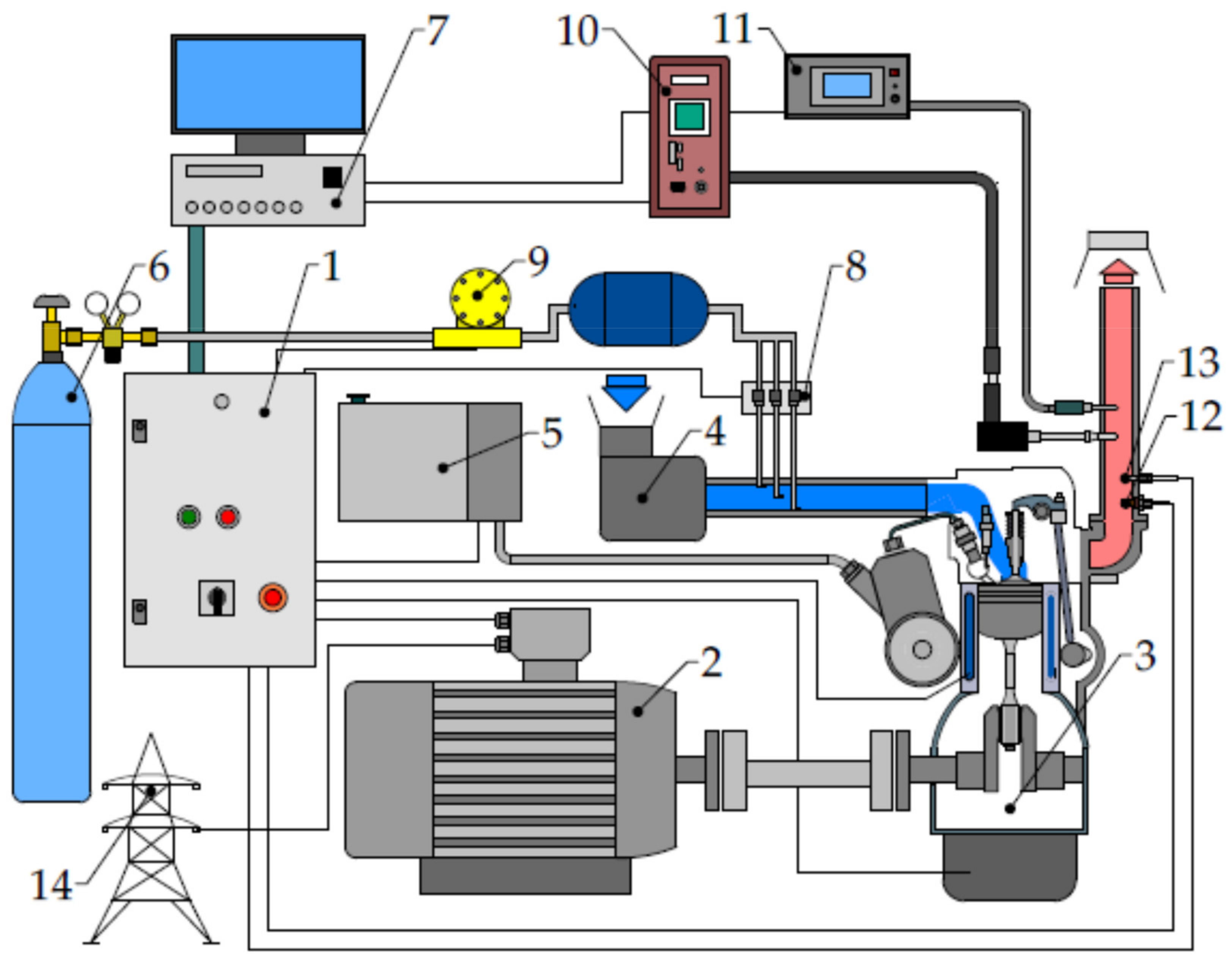
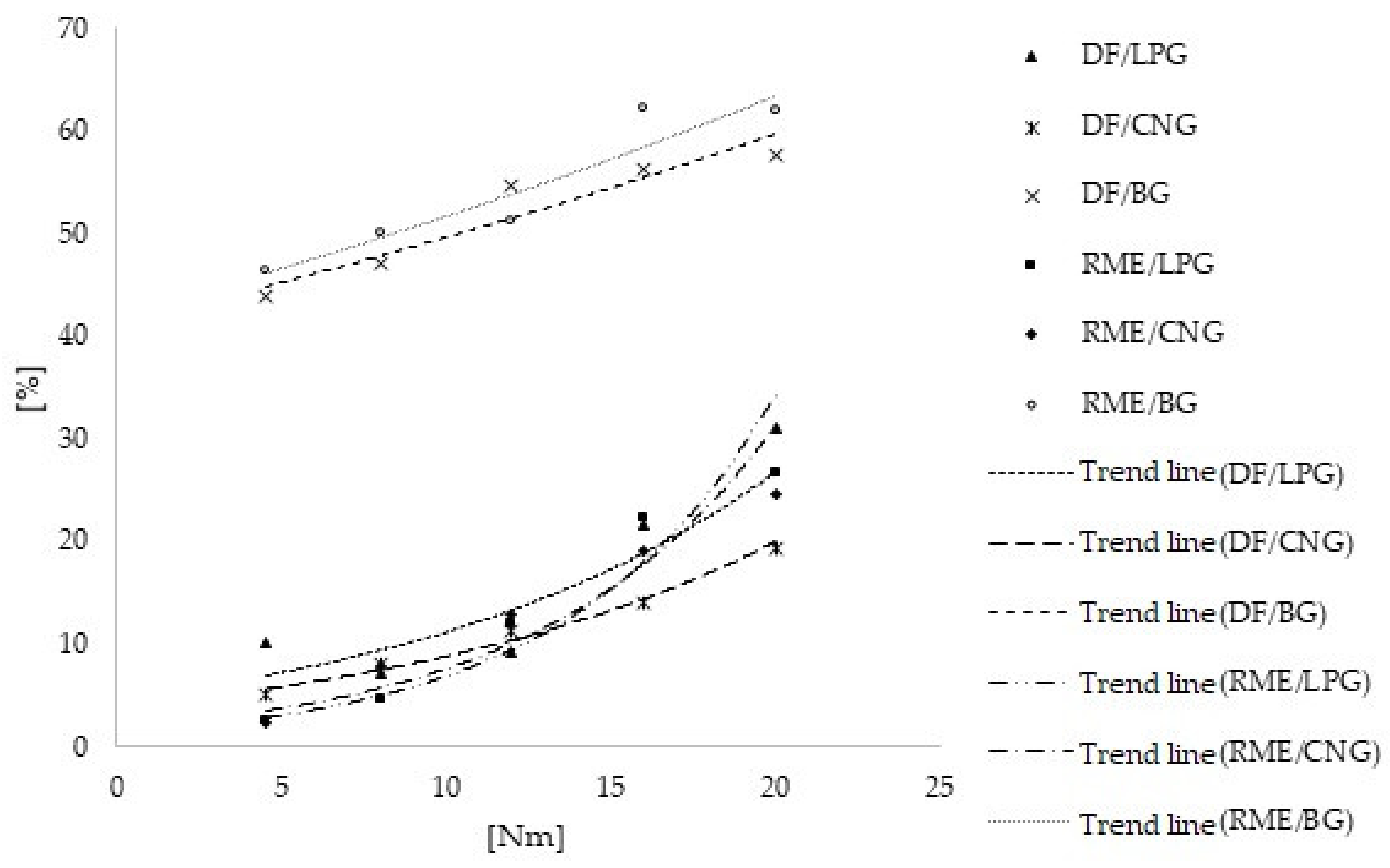
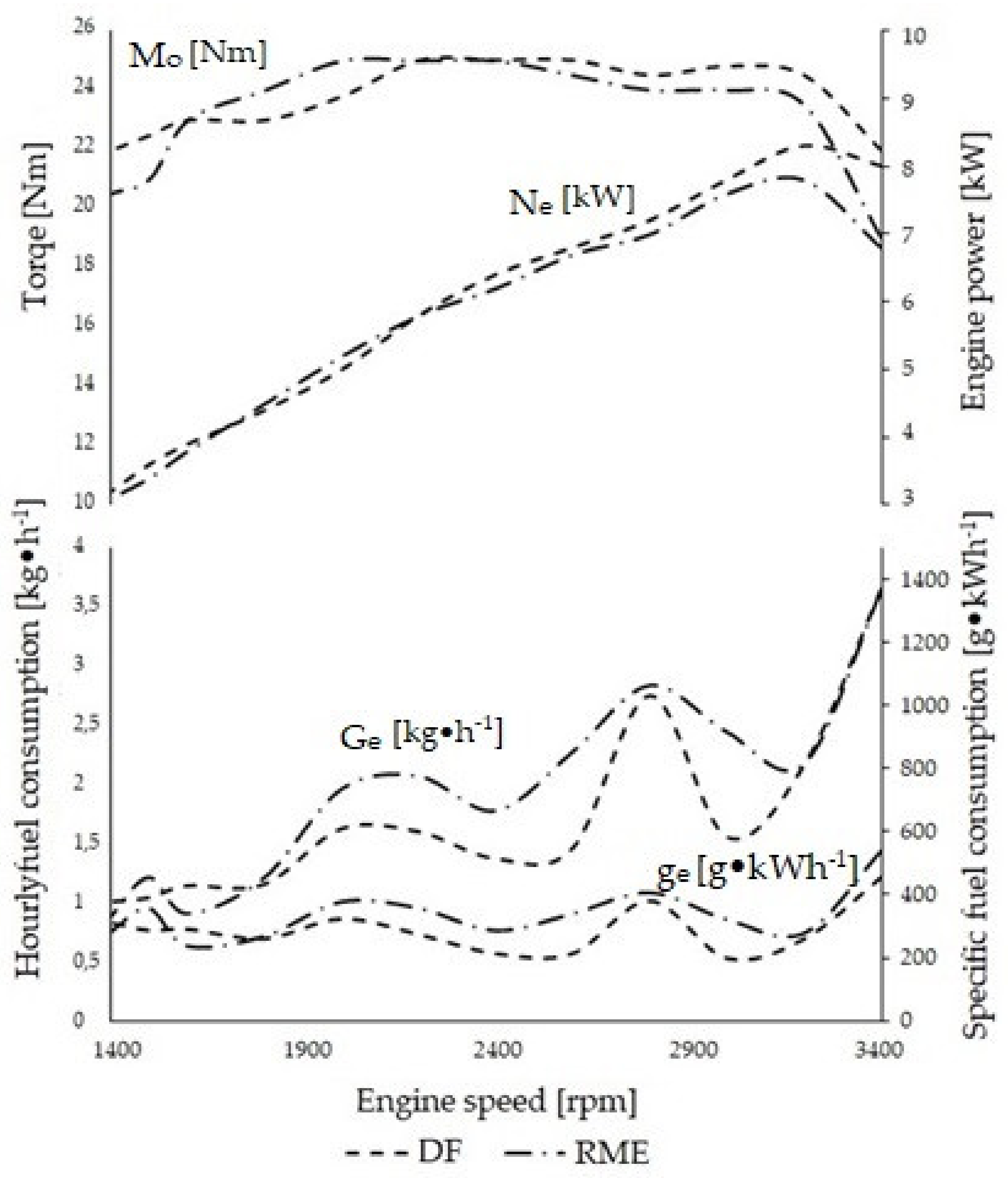

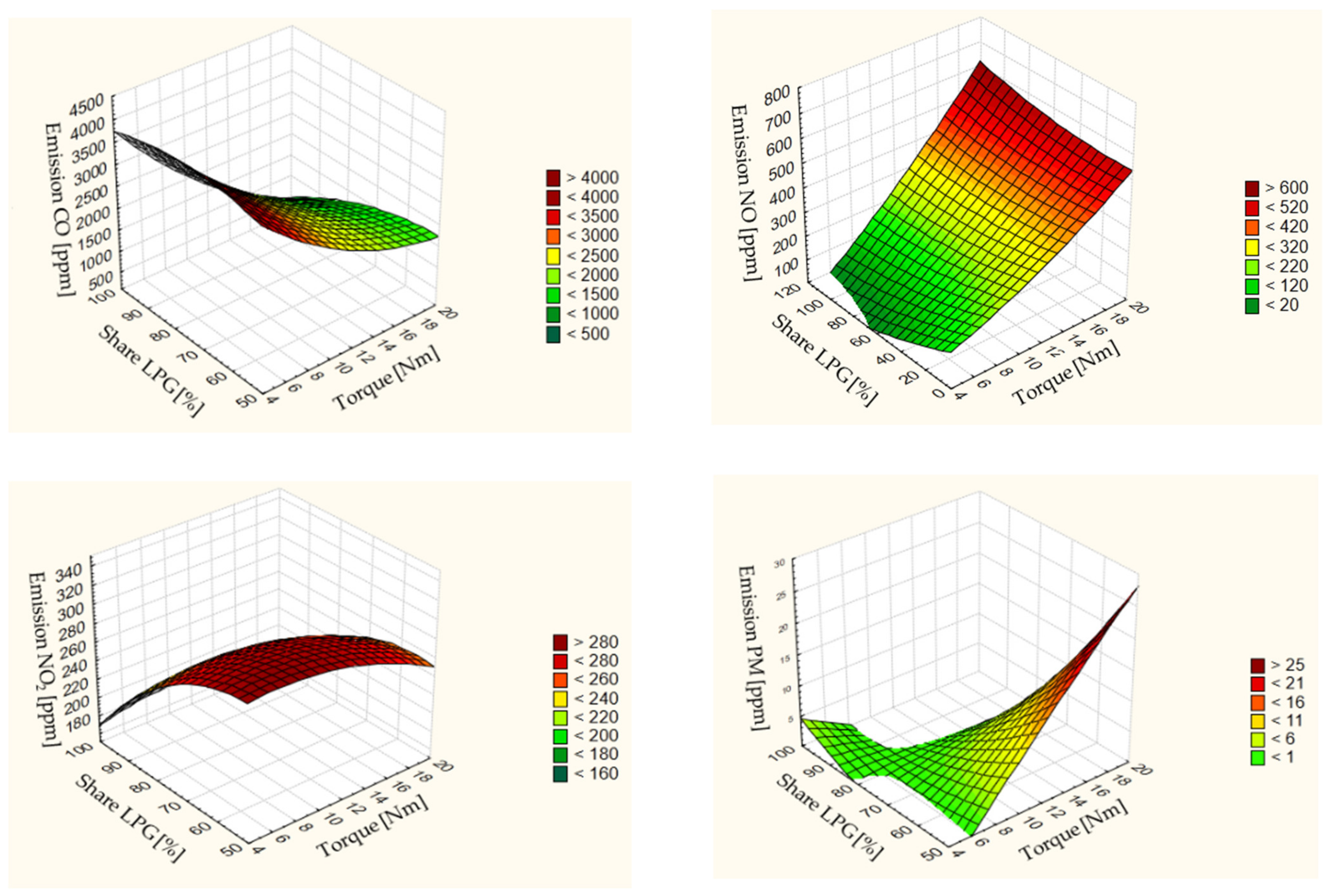
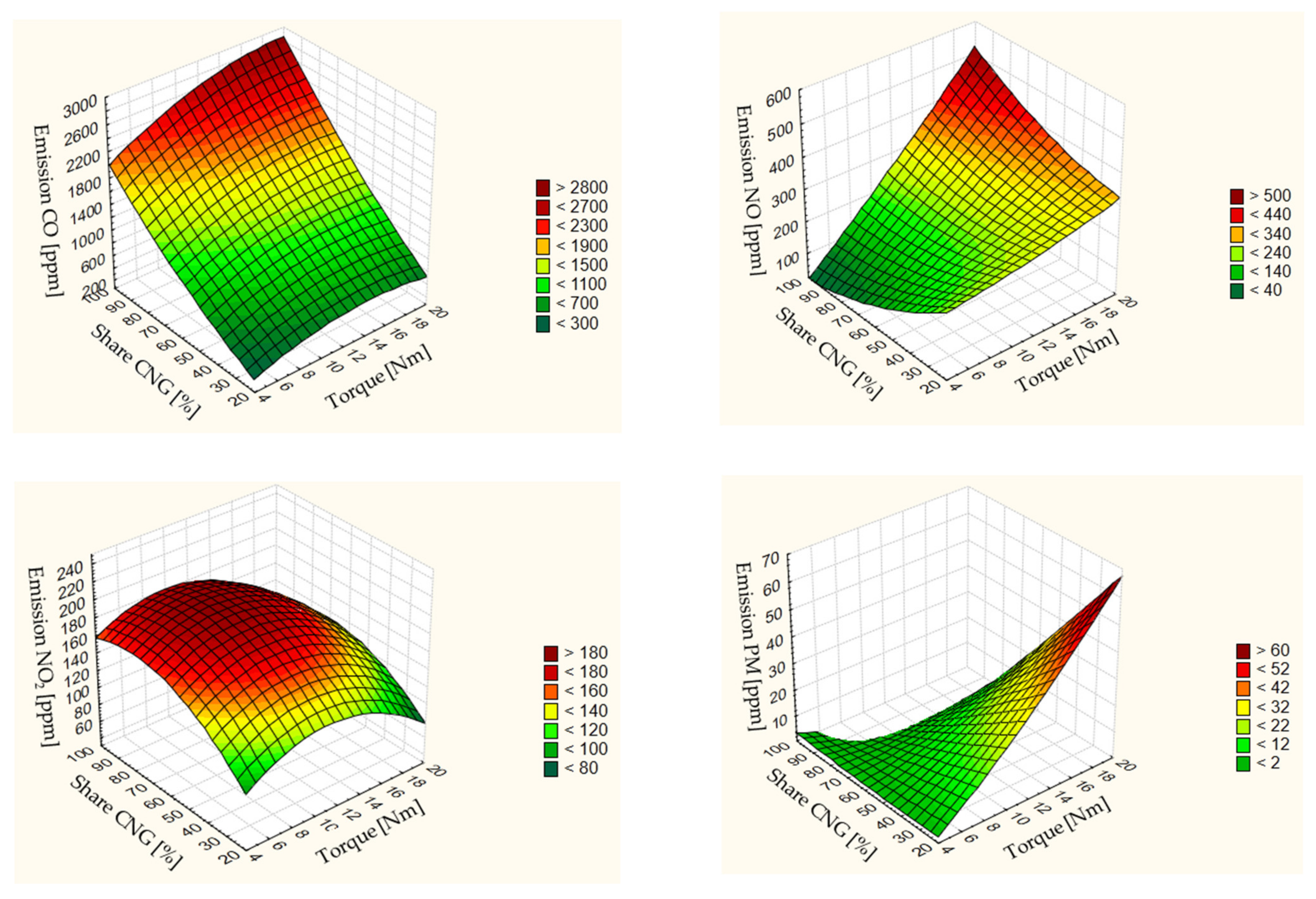
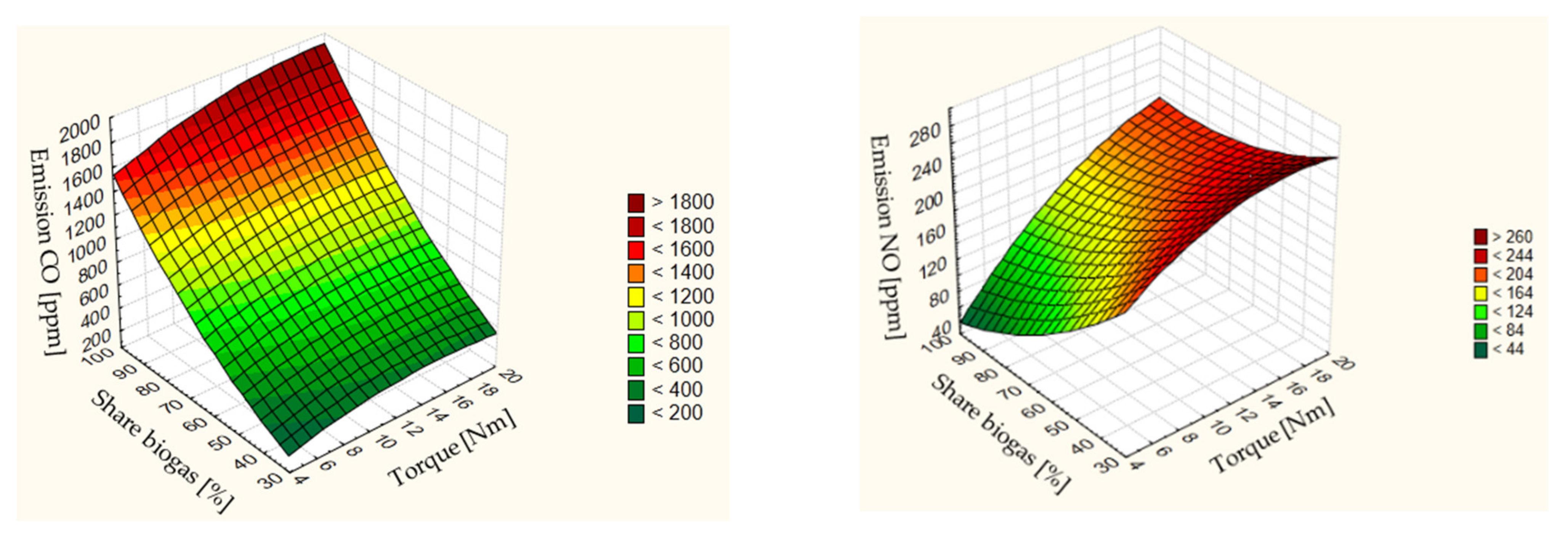
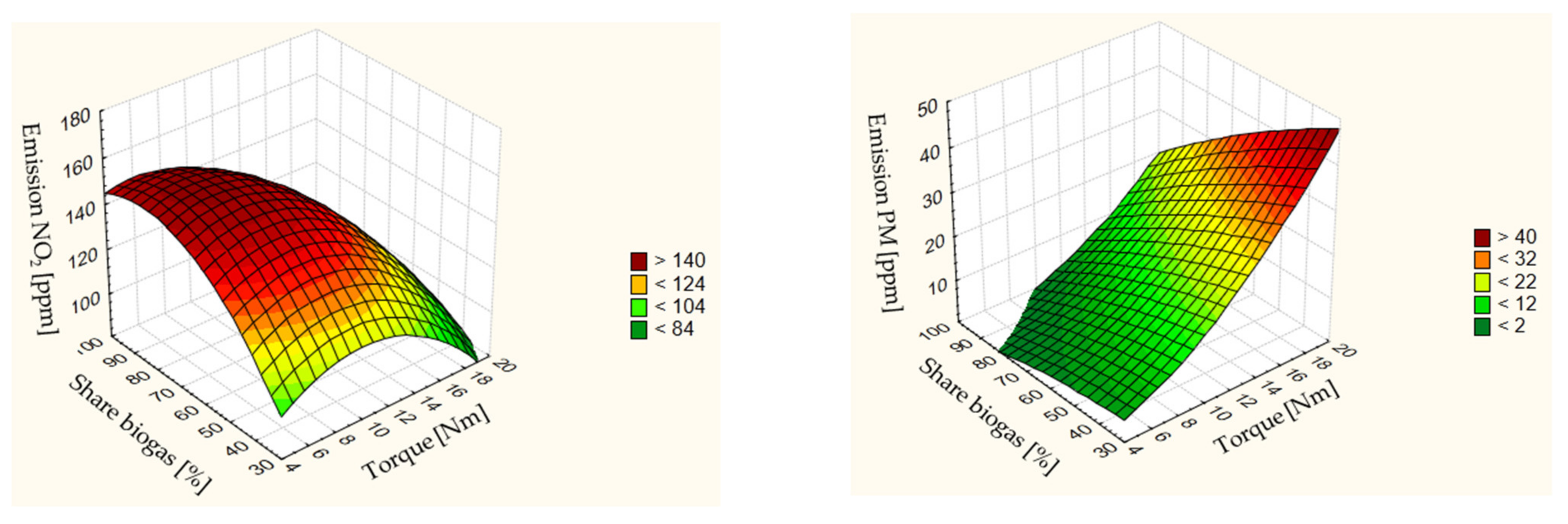

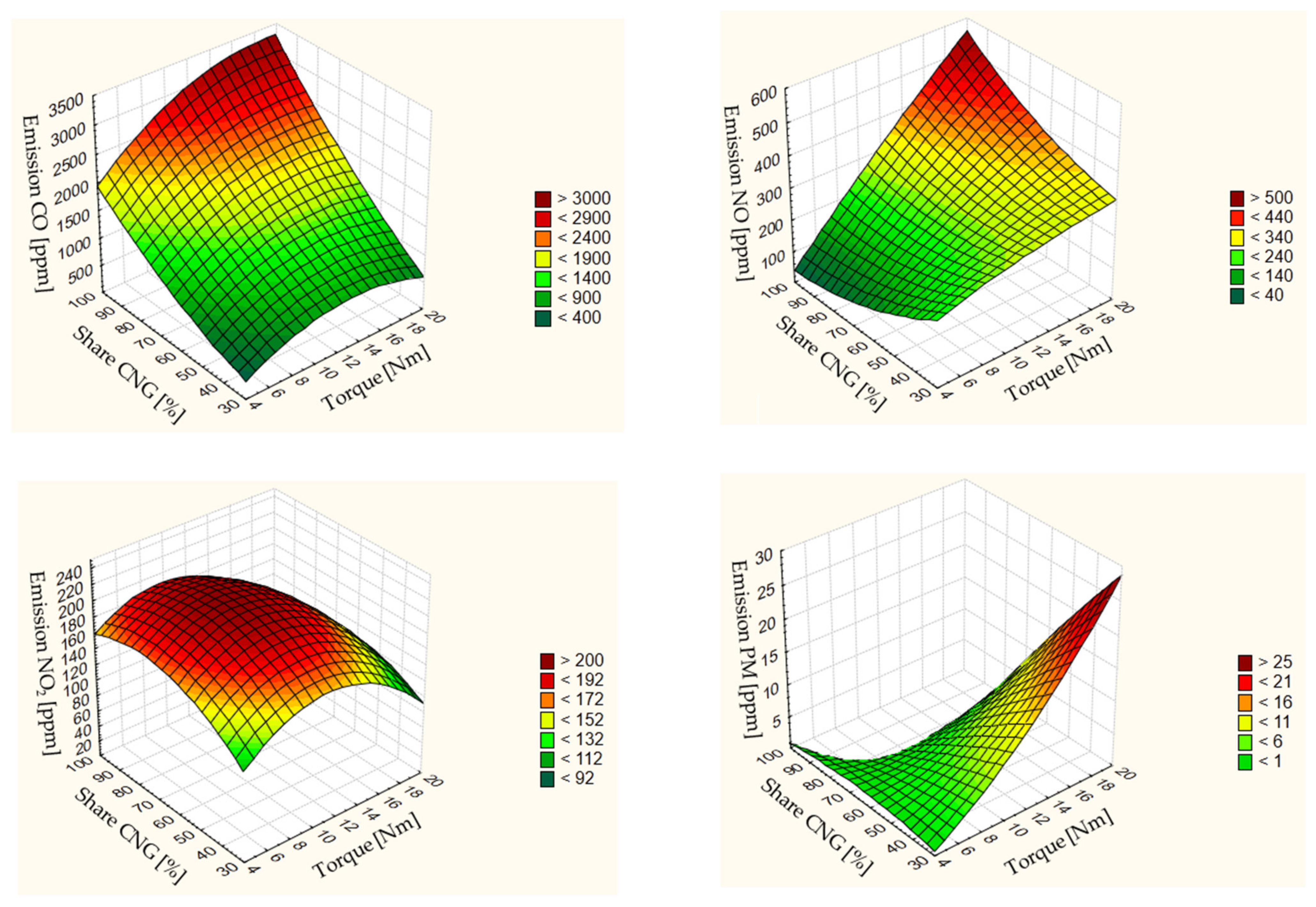
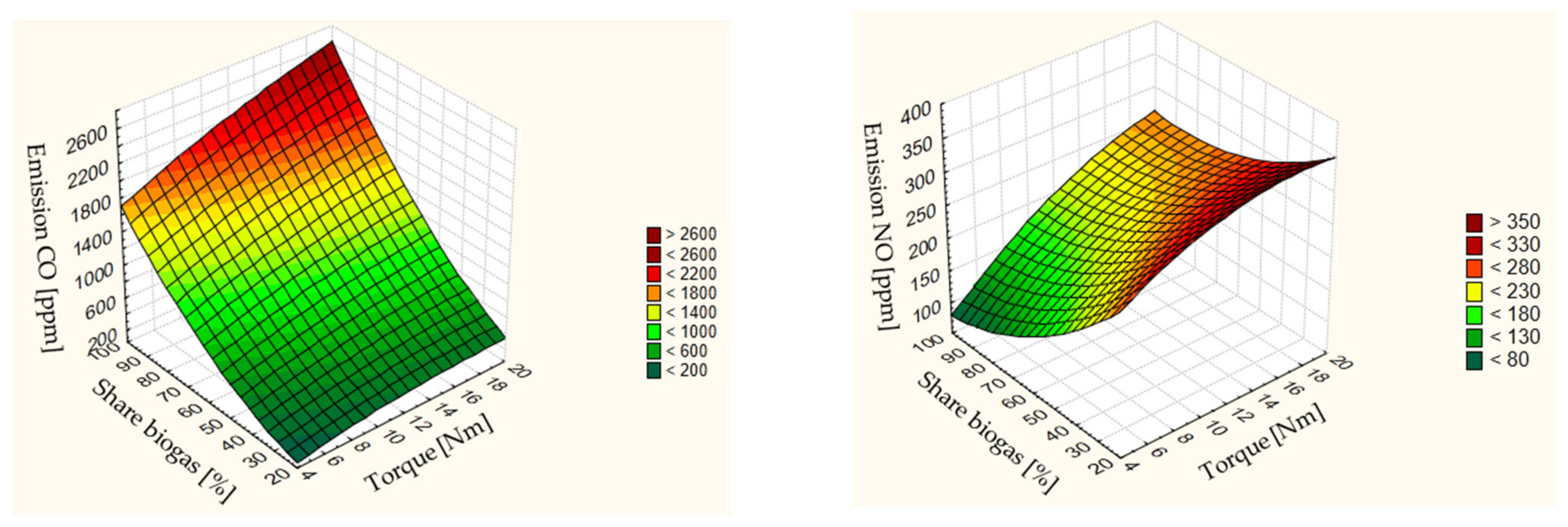
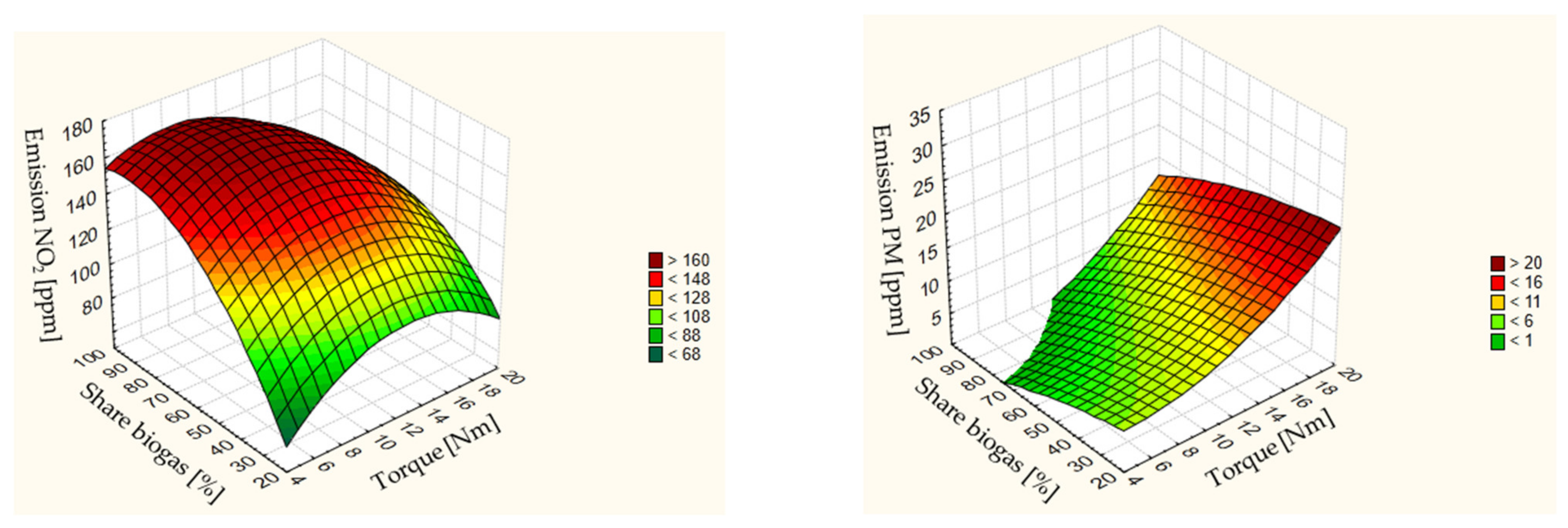
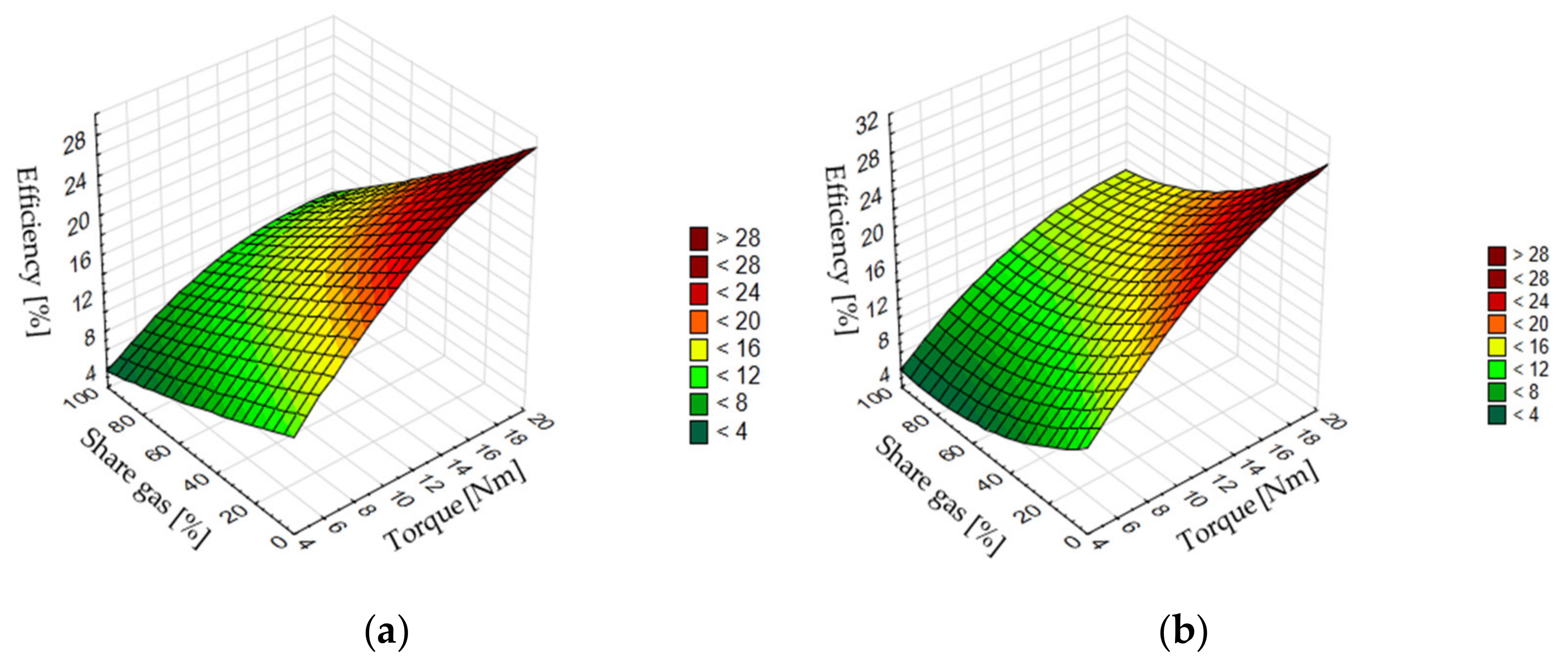

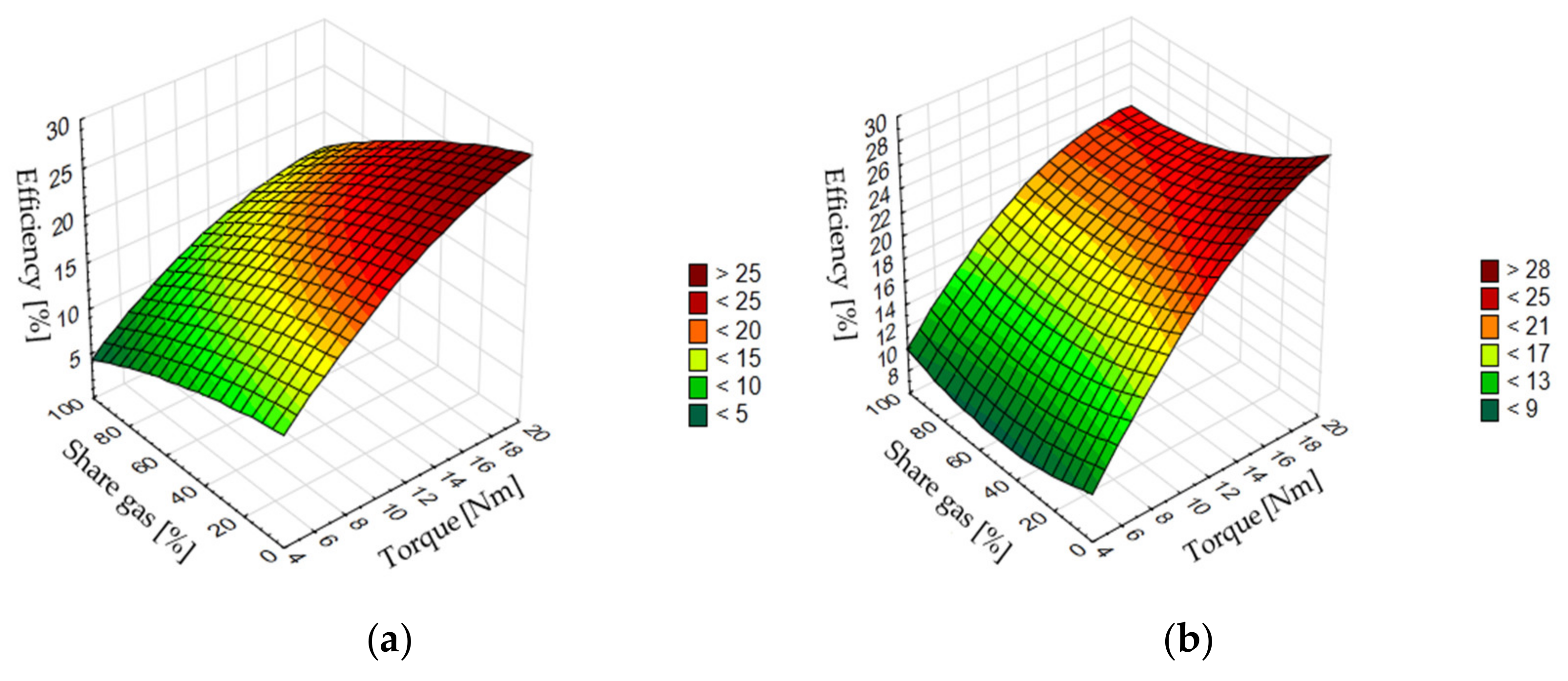
| Engine Model | 2TNV70 |
|---|---|
| Ignition system | CI |
| Air system | Naturally Aspirated |
| Cylinder number | 2 |
| Displacement | 0.57 L |
| Engine power | 3400 obr·min−1 9.76 kW |
| Type of cooling | Liquid cooling |
| Model | OMT1-160M2 |
|---|---|
| Rated power | 15 [kW] |
| Maximum speed | 3400 [rpm] |
| Rated current | 400/690 [V] 20.4/11.8 [A] |
| Rated torque [Nm] | 36 |
| Names of Higher Fatty Acids Determined | [%] | |
|---|---|---|
| Myristic | (C 14:0) | - |
| Palmitic | (C 16:0) | 0.55 |
| Palmitoleic | (C 16:1) | 4.6 |
| Stearic | (C 18:0) | 1.63 |
| Oleic | (C 18:1) | 61.96 |
| Linoleic | (C 18:2) | 18.11 |
| Linolenic | (C 18:3) | 9.6 |
| Arachidonic | (C 20:0) | 0.57 |
| Eikosaniod | (C 20:1) | 1.43 |
| Others | 1.55 | |
| Fuel Properties | RME | DF | BG | LPG/CNG |
|---|---|---|---|---|
| Viscosity 40 °C (mm2·s−1) | 4.79 | 2.91 | - | - |
| Density 15 °C (kg·m−3) | 884.9 | 836.7 | 1.25 | 0.7/0.8 * |
| Calorific value (MJ/kg) | 38.2 | 42.6 | 17.6 | 45.93/50.05 |
| Gas | Content | Measurement Error | |
|---|---|---|---|
| Hydrogen sulfide | H2S | 28 ppm | ±10% |
| Methane | CH4 | 59.9% (v/v) | ±3% |
| Carbon dioxide | CO2 | 41.7% (v/v) | ±3% |
| Oxygen | O2 | 0.7% (v/v) | ±1% |
| No. | Test Configuration |
|---|---|
| I | DF + LPG |
| II | DF + CNG |
| III | DF + BG |
| IV | RME + LPG |
| V | RME + CNG |
| VI | RME + BG |
Publisher’s Note: MDPI stays neutral with regard to jurisdictional claims in published maps and institutional affiliations. |
© 2021 by the authors. Licensee MDPI, Basel, Switzerland. This article is an open access article distributed under the terms and conditions of the Creative Commons Attribution (CC BY) license (https://creativecommons.org/licenses/by/4.0/).
Share and Cite
Gracz, W.; Marcinkowski, D.; Golimowski, W.; Szwajca, F.; Strzelczyk, M.; Wasilewski, J.; Krzaczek, P. Multifaceted Comparison Efficiency and Emission Characteristics of Multi-Fuel Power Generator Fueled by Different Fuels and Biofuels. Energies 2021, 14, 3388. https://doi.org/10.3390/en14123388
Gracz W, Marcinkowski D, Golimowski W, Szwajca F, Strzelczyk M, Wasilewski J, Krzaczek P. Multifaceted Comparison Efficiency and Emission Characteristics of Multi-Fuel Power Generator Fueled by Different Fuels and Biofuels. Energies. 2021; 14(12):3388. https://doi.org/10.3390/en14123388
Chicago/Turabian StyleGracz, Weronika, Damian Marcinkowski, Wojciech Golimowski, Filip Szwajca, Maria Strzelczyk, Jacek Wasilewski, and Paweł Krzaczek. 2021. "Multifaceted Comparison Efficiency and Emission Characteristics of Multi-Fuel Power Generator Fueled by Different Fuels and Biofuels" Energies 14, no. 12: 3388. https://doi.org/10.3390/en14123388
APA StyleGracz, W., Marcinkowski, D., Golimowski, W., Szwajca, F., Strzelczyk, M., Wasilewski, J., & Krzaczek, P. (2021). Multifaceted Comparison Efficiency and Emission Characteristics of Multi-Fuel Power Generator Fueled by Different Fuels and Biofuels. Energies, 14(12), 3388. https://doi.org/10.3390/en14123388








